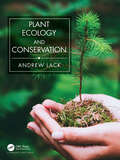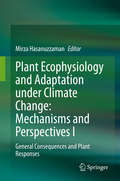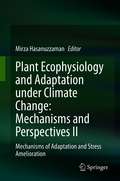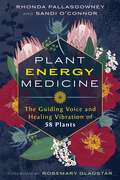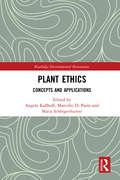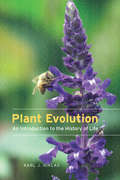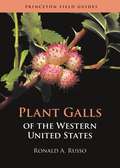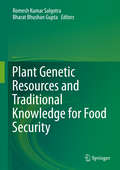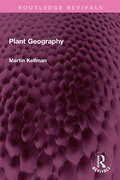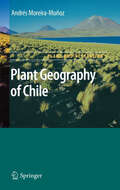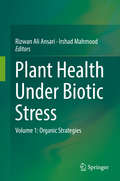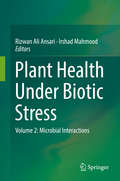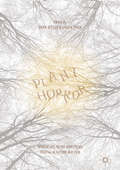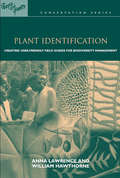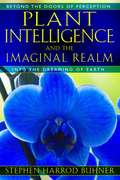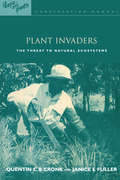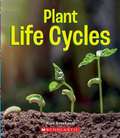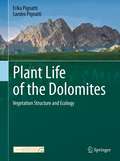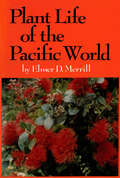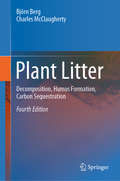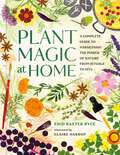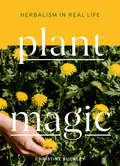- Table View
- List View
Plant Ecology and Conservation
by Andrew LackPlant Ecology & Conservation is an introduction to the world of plant ecology. It includes the main areas of current research including ideas about plant populations, nutrition and plant community ecology and has a particular emphasis on the interactions of plants with animals, fungi and microorganisms whose important is being increasingly demonstrated. With the world’s environmental problems having such a high profile, the book focusses on the human impact on the world’s plant species. Conservation of the terrestrial world starts with plants as they form the basis of all ecosystems on land. We can only understand how best to conserve the world’s biodiversity with an understanding of the central role of plant ecology. This theme runs throughout with numerous examples of the disruption of ecosystems by human activity emphasising the connection between plant ecology and conservation. Key Features: Boxes present case studies, important statistics and interesting asides Full-colour photos depict key species and habitats and superb line drawings illustrate many concepts Important data are presented in Tables and Figures throughout Each chapter has Key Concepts and review questions to test a reader’s grasp of the content Key References and Further Reading are given for each chapter to point the reader towards the most important and influential literature Jargon is kept to a minimum and a full Glossary of all technical terms is presented The book is aimed primarily at undergraduate and graduate students in any aspect of ecology or plant science. It should also appeal to anyone interested in how plants function and are concerned about what is needed for the conservation of the world’s ecosystems.
Plant Ecology in a Changing World
by Russell K. Monson James R. EhleringerToday global changes and human activities affect plants within each of the world’s ecosystems. Plant Ecology in a Changing World provides a foundation for understanding how the changes underway impact structure and function in the world’s major biomes, while also describing how evolution has resulted in the biochemical, physiological, structural, and life history features that shaped plants and their capacities to persist across widely contrasting environments. This textbook is designed for undergraduate students and graduate students as well to serve as a resource for climate change and ecosystem scientists seeking a foundation on the principles of plant ecology and the basis of plant adaptations. While many textbooks focus primarily on natural ecosystems, Plant Ecology in a Changing World also recognizes the ecological importance of invasive, managed, and urban ecosystems and of the ways in which ecosystems are already being impacted by both human activities and a warming planet.Key features: Replete with 450+ figures that help to elucidate concepts and charts to clearly present key data Boxes within chapters allow those who wish to delve into more advanced aspects of topics and of those key methodological approaches used to quantify processes Highlights of key plant ecologists and of their contributions Each chapter concludes with a bulleted summary, enabling students to recap the key points of the chapter Each chapter comes with both a list of references, as well as with suggested readings, allowing the student to expand their knowledge on a particular topic Associated with the book is an array of supplementary materials. These are available and constantly updated at http://plantecology.site.
Plant Ecophysiology and Adaptation under Climate Change: General Consequences and Plant Responses
by Mirza HasanuzzamanThis book presents the state-of-the-art in plant ecophysiology. With a particular focus on adaptation to a changing environment, it discusses ecophysiology and adaptive mechanisms of plants under climate change. Over the centuries, the incidence of various abiotic stresses such as salinity, drought, extreme temperatures, atmospheric pollution, metal toxicity due to climate change have regularly affected plants and, and some estimates suggest that environmental stresses may reduce the crop yield by up to 70%. This in turn adversely affects the food security. As sessile organisms, plants are frequently exposed to various environmental adversities. As such, both plant physiology and plant ecophysiology begin with the study of responses to the environment. Provides essential insights, this book can be used for courses such as Plant Physiology, Environmental Science, Crop Production and Agricultural Botany.Volume 1 provides up-to-date information on the impact of climate change on plants, the general consequences and plant responses to various environmental stresses.
Plant Ecophysiology and Adaptation under Climate Change: Mechanisms of Adaptation and Stress Amelioration
by Mirza HasanuzzamanThis book presents the state-of-the-art in plant ecophysiology. With a particular focus on adaptation to a changing environment, it discusses ecophysiology and adaptive mechanisms of plants under climate change. Over the centuries, the incidence of various abiotic stresses such as salinity, drought, extreme temperatures, atmospheric pollution, metal toxicity due to climate change have regularly affected plants and, and some estimates suggest that environmental stresses may reduce the crop yield by up to 70%. This in turn adversely affects the food security. As sessile organisms, plants are frequently exposed to various environmental adversities. As such, both plant physiology and plant ecophysiology begin with the study of responses to the environment. Provides essential insights, this book can be used for courses such as Plant Physiology, Environmental Science, Crop Production and Agricultural Botany.Volume 2 provides up-to-date information on the impact of climate change on plants, the general consequences and plant responses to various environmental stresses.
Plant Energy Medicine: The Guiding Voice and Healing Vibration of 58 Plants
by Rhonda PallasDowney Sandi O'Connor• Presents in-depth teachings on 58 flowers, trees, and plants• Each write-up features a full-color close-up photo along with the plant&’s medicinal and flower essence traits, the voice of its flower, energetic impact on the chakras, and an affirmation• Also explores plant biofield energetics, how to use flower essences, and the sensory experience of connecting with a plantBy learning to listen quietly to flowers and plants, we can tune in to the inner teachings they have to offer us. Plants can not only heal us, but they can also teach us how to live a more joyful, healthy, and balanced life.Sharing the teachings they&’ve received through years of attentive listening to flowers, trees, and plants, Rhonda PallasDowney and Sandi O&’Connor explore how to deepen your personal experience with the world of plants and connect with their energies. They look at the life force energy of plants, their sensory systems, biofields and electromagnetic energy fields, and their growth from seed to root to stem to leaf to blossom. They offer insights into how to deepen your sensory experience of plants—including their taste, texture, and sounds—and they also teach you how to work with flower essences.Presenting in-depth teachings on 58 flowers, trees, and plants, the authors explore each plant&’s medicinal and flower essence traits, the voice of its flower, its insight, its energetic impact on the chakras, and an affirmation to help you embody the teachings of the plant. Each plant discussion also features full-color close-up photos by Rhonda PallasDowney that capture the energetic imprint and personality of the plant.
Plant Ethics: Concepts and Applications (Routledge Environmental Humanities)
by Angela Kallhoff, Marcello Di Paola and Maria SchörgenhumerLarge parts of our world are filled with plants, and human life depends on, interacts with, affects and is affected by plant life in various ways. Yet plants have not received nearly as much attention from philosophers and ethicists as they deserve. In environmental philosophy, plants are often swiftly subsumed under the categories of "all living things" and rarely considered thematically. There is a need for developing a more sophisticated theoretical understanding of plants and their practical role in human experience. Plant Ethics: Concepts and Applications aims at opening a philosophical discussion that may begin to fill that gap. The book investigates issues in plants ontology, ethics and the role of plants and their cultivation in various fields of application. It explores and develops important concepts to shape and frame plants-related philosophical questions accurately, including new ideas of how to address moral questions when confronted with plants in concrete scenarios. This edited volume brings together for the first time, and in an interdisciplinary spirit, contemporary approaches to plant ethics by international scholars of established reputation. It will be of great interest to students and scholars of Philosophy and Ethics.
Plant Evolution: An Introduction to the History of Life
by Karl J. NiklasAlthough plants comprise more than 90% of all visible life, and land plants and algae collectively make up the most morphologically, physiologically, and ecologically diverse group of organisms on earth, books on evolution instead tend to focus on animals. This organismal bias has led to an incomplete and often erroneous understanding of evolutionary theory. Because plants grow and reproduce differently than animals, they have evolved differently, and generally accepted evolutionary views—as, for example, the standard models of speciation—often fail to hold when applied to them. Tapping such wide-ranging topics as genetics, gene regulatory networks, phenotype mapping, and multicellularity, as well as paleobotany, Karl J. Niklas’s Plant Evolution offers fresh insight into these differences. Following up on his landmark book The Evolutionary Biology of Plants—in which he drew on cutting-edge computer simulations that used plants as models to illuminate key evolutionary theories—Niklas incorporates data from more than a decade of new research in the flourishing field of molecular biology, conveying not only why the study of evolution is so important, but also why the study of plants is essential to our understanding of evolutionary processes. Niklas shows us that investigating the intricacies of plant development, the diversification of early vascular land plants, and larger patterns in plant evolution is not just a botanical pursuit: it is vital to our comprehension of the history of all life on this green planet.
Plant Galls of the Western United States (Princeton Field Guides #149)
by Ronald A. RussoA photographic guide to 536 species of plant galls found west of the RockiesBeautiful and bizarre, plant galls are growths of various shapes, sizes, and colors produced in response to invading organisms. Describing 536 species of galls and their causative agents, Plant Galls of the Western United States explores this unique realm with stunning photos and fascinating information about the life cycles of the organisms involved.Often species-specific, plant galls can be shaped like stars, baskets, clubs, wigs, bowls, and cups, with colors and combinations that stagger the imagination. This richly illustrated field guide examines how galls develop, and their uses, seasonal appearance and growth rate, predators, and defense mechanisms. The “architects” of galls—bacteria, fungi, mites, moths, beetles, flies, midges, and wasps—are explored in depth, and descriptions are paired with illustrations of these gall-inducing organisms and their typical galls. Gall accounts are divided into those that occur on trees, shrubs, and miscellaneous hosts, including native and ornamental plants. The guide contains a useful glossary and a bibliography.Features 536 gall species—including 120 new to science and 232 that have never appeared in a field guide beforeExamines for the first time more than 90 species from southwestern oak treesContains more than 150 species from most of the deserts of the western states
Plant Genetic Resources and Traditional Knowledge for Food Security
by Romesh Kumar Salgotra Bharat Bhushan GuptaWith exponentially increasing population across the globe and shrinking resources, the concern of food security is looming large over the world community. To catch up with the fierce pace of growth in all the sectors of development, ensuring uninhibited availability of food resources is a prime agenda. The growing global demand for food, feed, fiber and bio-based renewable materials, such as bio-fuels, is changing the conditions for genetic resources development and bio-resource production worldwide. The crucial role in ensuring food security is played by the agro-based industries and enterprises. Advances in plant genetic resources coupled with traditional knowledge of the local tribes and native practices facilitate achievement of food security.
Plant Geography (Routledge Revivals)
by Martin KellmanOriginally published in 1975 and in a second edition in 1980, Plant Geography was the first text in biogeography that provided an adequate treatment of modern plant population theory. It is an introduction to the subject for students of both geography and biology. The author develops a series of plant geographic concepts that are based primarily in plant population biology, treating in turn processes that operate at the level of the individual plant and the plant population; interactions between plant populations; environmental conditions and plant dissemination in shaping plant species’ distributions, and the geography of vegetation. Emphasis throughout is placed upon the dynamic nature of the earth’s plant cover, and the interplay between contemporary conditions and historical events in shaping plant distributions and evolution.
Plant Geography of Chile
by Andres Moreira-MunozThe first and so far only Plant Geography of Chile was written about 100 years ago, since when many things have changed: plants have been renamed and reclassified; taxonomy and systematics have experienced deep changes as have biology, geography, and biogeography. The time is therefore ripe for a new look at Chile's plants and their distribution. Focusing on three key issues - botany/systematics, geography and biogeographical analysis - this book presents a thoroughly updated synthesis both of Chilean plant geography and of the different approaches to studying it. Because of its range - from the neotropics to the temperate sub-Antarctic - Chile's flora provides a critical insight into evolutionary patterns, particularly in relation to the distribution along the latitudinal profiles and the global geographical relationships of the country's genera. The consequences of these relations for the evolution of the Chilean Flora are discussed. This book will provide a valuable resource for both graduate students and researchers in botany, plant taxonomy and systematics, biogeography, evolutionary biology and plant conservation.
Plant Health Under Biotic Stress: Volume 1: Organic Strategies
by Rizwan Ali Ansari Irshad MahmoodThe current scenario of increasing sensitivity towards the sustainable agriculture has given a large space to extensively utilize natural resources that are environmental friendly and are a good replacement of chemicals in agriculture. Application of organic additives in the sustainable disease management can provide new insight in sustenance of plant productivity along with improved host stress tolerance. In the present book we have focussed upon a range of organic strategies to control plant pathogens of wide spectrum in addition to maintaining robust plant health. A detailed account on the application of organic additives has been discussed, irrespective of their origin and nature. In addition, the methods of utilising these organic supplements in the management of plant diseases and promotion of plant yield in more economic way have also been presented with reference to developing, underdeveloped and developed countries. The book has included the works of eminent scholars from across the world thus flashing light on the key literature related to application of organic matters including phytoextracts, chopped leaves, composted organic manures and liquid manures in eco-friendly agriculture. The mechanisms underlying the effectiveness of these organic amendments in promoting plant health has also been presented and discussed in understandable ways.
Plant Health Under Biotic Stress: Volume 2: Microbial Interactions
by Rizwan Ali Ansari Irshad MahmoodThe book illustrates the use of putative microbial agents which provide good protection to the plant from biotic pathogens attack. An up to date knowledge on plant-microbiome interaction strategies in terms of improved sustainability has been discussed. Information from experts across the globe on the application of microbes for providing amicable solution in sustainable agriculture has been gathered. In addition, information related to microbes mediated resistance levels leading to enhanced plant health has been well presented. The chapters have emphasised the use of Plant Growth Promoting Rhizobacteria (PGPR) and other potential biocontrol agents/antagonists in the management of plant diseases which provide extensive information to the readers. Literature on microbial root colonization, plant growth promotions, and also on the protection of plants from attack of various soil borne pathogens have been presented in a coherent way. Information on the application of potential strain of the bio-control fungi, endophytes, actinomycetes strengthening the plants ability which rescue the plant from pathogens attack leading to improved plant health has also been underpinned.
Plant Horror
by Dawn Keetley Angela TengaThis collection explores artistic representations of vegetallife that imperil human life, voicing anxieties about our relationship to otherlife forms with which we share the earth. From medieval manuscriptillustrations to modern works of science fiction and horror, plants thatmanifest monstrous agency defy human control, challenge anthropocentricperception, and exact a violent vengeance for our blind and exploitativepractices. Plant Horror explores howdepictions of monster plants reveal concerns about the viability of ourprevailing belief systems and dominant ideologies-- as well as a deep-seatedfear about human vulnerability in an era of deepening ecological crisis. Filmsdiscussed include The Day of the Triffids, Invasion of the Body Snatchers, TheWicker Man, Swamp Thing, and The Happening.
Plant Identification: Creating User-Friendly Field Guides for Biodiversity Management
by Anna Lawrence William HawthorneAn important prerequisite for successful conservation is a good understanding of what we seek to conserve. Nowhere is this more the case than in the fight to protect plant biodiversity, which is threatened by human activity in many regions worldwide. This book is written in the belief that tools that enable more people to understand biodiversity can not only aid protection efforts but also contribute to rural livelihoods. Among the most important of those tools is the field guide. Plant Identification provides potential authors of field guides with practical advice about all aspects of producing user-friendly guides which help to identify plants for the purposes of conservation, sustainable use, participatory monitoring or greater appreciation of biodiversity. The book draws on both scientific and participatory processes, supported by the experience of contributors from across the tropics. It presents a core process for producing a field guide, setting out key steps, options and techniques available to the authors of a guide and, through illustration, helps authors choose methods and media appropriate to their context.
Plant Intelligence and the Imaginal Realm: Beyond the Doors of Perception into the Dreaming of Earth
by Stephen Harrod BuhnerA manual for opening the doors of perception and directly engaging the intelligence of the Natural World • Provides exercises to directly perceive and interact with the complex, living, self-organizing being that is Gaia • Reveals that every life form on Earth is highly intelligent and communicative • Examines the ecological function of invasive plants, bacterial resistance to antibiotics, psychotropic plants and fungi, and the human species In Plant Intelligence and the Imaginal Realm, Stephen Harrod Buhner reveals that all life forms on Earth possess intelligence, language, a sense of I and not I, and the capacity to dream. He shows that by consciously opening the doors of perception, we can reconnect with the living intelligences in Nature as kindred beings, become again wild scientists, nondomesticated explorers of a Gaian world just as Goethe, Barbara McClintock, James Lovelock, and others have done. For as Einstein commented, “We cannot solve the problems facing us by using the same kind of thinking that created them.” Buhner explains how to use analogical thinking and imaginal perception to directly experience the inherent meanings that flow through the world, that are expressed from each living form that surrounds us, and to directly initiate communication in return. He delves deeply into the ecological function of invasive plants, bacterial resistance to antibiotics, psychotropic plants and fungi, and, most importantly, the human species itself. He shows that human beings are not a plague on the planet, they have a specific ecological function as important to Gaia as that of plants and bacteria. Buhner shows that the capacity for depth connection and meaning-filled communication with the living world is inherent in every human being. It is as natural as breathing, as the beating of our own hearts, as our own desire for intimacy and love. We can change how we think and in so doing begin to address the difficulties of our times.
Plant Invaders: The Threat to Natural Ecosystems (People and Plants International Conservation #Vol. 1)
by Quentin C.B. Cronk Janice L. FullerA practical guide to the protection and management of ecosystems against invasions by non-indigenous plant species. The authors seek to offer an accessible account of the subject and how to protect natural habitats. The majority of countries suffer from invasive plants and there are case studies from North America, Europe, Australia, South and South East Asia and the Pacific and Atlantic islands. There is also a list of invasive species, with their countries of origin and regions of introduction.
Plant Life Cycles (A True Book)
by Mara GrunbaumIncredible Plants series introduces young investigative readers to many types of unusual and typical plants from photosynthesis, how they grow, and ways they survive in extreme environments.
Plant Life of the Dolomites
by Erika Pignatti Sandro PignattiThis volume provides an in-depth analysis of over 100 plant communities of the Dolomite vegetation. The data is based on the phytosociological relevés, which have been collected by the authors in nearly 2000 surveys. The key part consists of approx. 130 association tables presenting plant sociological data for the respective plant communities. Thus, this volume perfectly complements the successful main volume "Plant Life of the Dolomites: Vegetation Structure and Ecology," which features summarized, synoptic association tables of the twelve habitats. In addition, geo-referenced locations of relevés and detailed ecological measures are provided. A further part describes the individual components of the fascinating dolomitic landscape (Heritage of all Humanity) and presents tables of vegetation complexes, which summarize the more than 400 surveys carried out in the Dolomites. The structure of this supplementary volume corresponds to that of the main volume with a key part consisting of twelve chapters, each describing a specific habitat, and a total of 106 associations. Several topics covered in the main volume, such as the exploration of the flora, ecological factors and syntaxonomy are discussed further here.
Plant Life of the Pacific World
by Elmer D. MerrillThis Asian ecology book offers an overview of the plant life of the vast Pacific region.Among the topics covered are the tropical forest and jungles, the grasslands, the primary and secondary forest, and the plants of the seashores. <P><P>Weeds and cultivated plants are also discussed with overviews of plant distribution and notes on specific islands and island groups.Plant Life of the Pacific World will fill a great need as an important reference source not only for the ethnobotanist but for the professional botanist and the student interested in the flora of the Pacific basin. The information it contains-adequately detailed and clearly presented-should also open the eyes of both visitors and inhabitants to the natural riches of the Pacific region.
Plant Life: The Entangled Politics of Afforestation
by Rosetta S. ElkinHow afforestation reveals the often-concealed politics between humans and plantsIn Plant Life, Rosetta S. Elkin explores the procedures of afforestation, the large-scale planting of trees in otherwise treeless environments, including grasslands, prairies, and drylands. Elkin reveals that planting a tree can either be one of the ultimate offerings to thriving on this planet, or one of the most extreme perversions of human agency over it. Using three supracontinental case studies—scientific forestry in the American prairies, colonial control in Africa&’s Sahelian grasslands, and Chinese efforts to control and administer territory—Elkin explores the political implications of plant life as a tool of environmentalism. By exposing the human tendency to fix or solve environmental matters by exploiting other organisms, this work exposes the relationship between human and plant life, revealing that afforestation is not an ecological act: rather, it is deliberately political and distressingly social. Plant Life ultimately reveals that afforestation cannot offset deforestation, an important distinction that sheds light on current environmental trends that suggest we can plant our way out of climate change. By radicalizing what conservation protects and by framing plants in their total aliveness, Elkin shows that there are many kinds of life—not just our own—to consider when advancing environmental policy.
Plant Litter: Decomposition, Humus Formation, Carbon Sequestration
by Björn Berg Charles McClaughertyThis book gives basic facts about litter decomposition studies, which are of guidance for scientists who start studies. Since the publication of the third edition, there has been quite a development not only in the field of litter decomposition but also in supporting branches of science, which are important for fruitful work on and understanding of decomposition of plant litter and sequestration of carbon. A consequence is that ‘old established truths’ are becoming outdated. New knowledge in the fields of phytochemistry and microbial ecology has given a new baseline for discussing the concepts ‘litter decomposition’ and ‘carbon sequestration’. We can also see a rich literature on litter decomposition studies using roots and wood as substrates. These have given new insights in factors that regulate the decomposition rate and as regards roots their contribution to sequestered carbon in humus. Additional facts on the role of temperature vs the litters’ chemical composition may in part change our view on effects of climate change. Further information on applications of the new analytical technique (13C-NMR) for determining organic-chemical compounds has allowed us to develop these parts. Focus is laid on needle litter of Scots pine as a model substrate as this species has been considerably more studied than other litter species. Also the boreal/northern temperate coniferous forest has in part been given this role. Still, new information may allow us to develop information about litter from further tree species.
Plant Magic at Home: A Complete Guide to Harnessing the Power of Nature from Rituals to DIYs
by Enid Baxter RyceUncover the ingredients to healing magic hiding right in your backyard with the help of this guide to powerful plants and the remedies and rituals ready to enhance your life. Whether you live in a forested lush area or are in the middle of a bustling urban environment, you can extract the properties and magic of plants. Plants hold the power of emotional and spiritual healing, which you can access through their physical or metaphysical properties. In this comprehensively researched book, split into three parts, (Gather, Harvest, Reap), you will learn how to forage or grow the plant, classify the plant, and then use its color or properties for no-waste sustainable spells or crafts. Specifically, you will come away with: Advice on practical foraging and gardening techniques Profiles of more than 90 plants, including trees, herbs, roots, flowers, fruits, and vegetables complete with information on the origins, practical uses, healing properties, and best techniques for extracting color Ancient and sustainable techniques such as Hapa Zome and Color Baths to obtain color from plants for no-waste art and projects Over 20 recipes and steps for natural inks, paints, and crafts including well-known inks like Walnut and Pokeberry, as well as kid-friendly projects like Berry-ink Spells throughout and a chapter on how to create your own Grimoire, or Spell book, with a collection on sample spells This book takes you on a full journey from root to ritual. It is full of joyful, easy-to-follow, DIY, no-waste recipes. You'll gain an appreciation for everything one seemingly simple plant can do for you—from its healing properties to its ability to provide for art.
Plant Magic: Herbalism in Real Life
by Christine BuckleyA fun, modern, and irreverent introduction to healing herbs, this field guide to feeling good includes more than 20 plant profiles.Here is an invitation to the wild world of healing plants growing right outside your door. Highlighting herbs from catnip and plantain to nettles and rosemary, this book provides the information you need to assemble an herbal arsenal for combatting any ailment—everything from brewing up a slick lube tea for sexual health to fashioning a simple summer band-aid from backyard &“weeds&” to crafting an herbal smoking blend to quiet a busy mind. This accessible guide covers questions like: What is plant medicine? What can I put in my mouth and where do I find it? Can I still go to my doctor? We&’ve got you covered.
Plant Man: The Life and Art of Makoto Azuma (Fountas & Pinnell Classroom, Guided Reading Grade 6)
by Nicole WalkerFrom Guitars to FLOWERS When a young rock musician struggled to pay his bills, he was forced to take a job doing something he never thought he'd do: work in a flower shop. But that fateful turn of events changed Makoto Azuma's life forever. His job soon evolved into a passion for transforming flowers into art. Now, his amazing and outrageous artwork never fails to surprise and delight audiences around the world. NIMAC-sourced textbook
